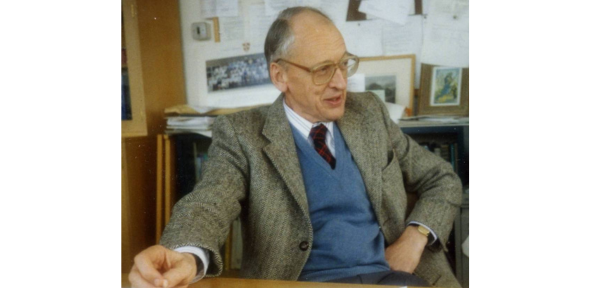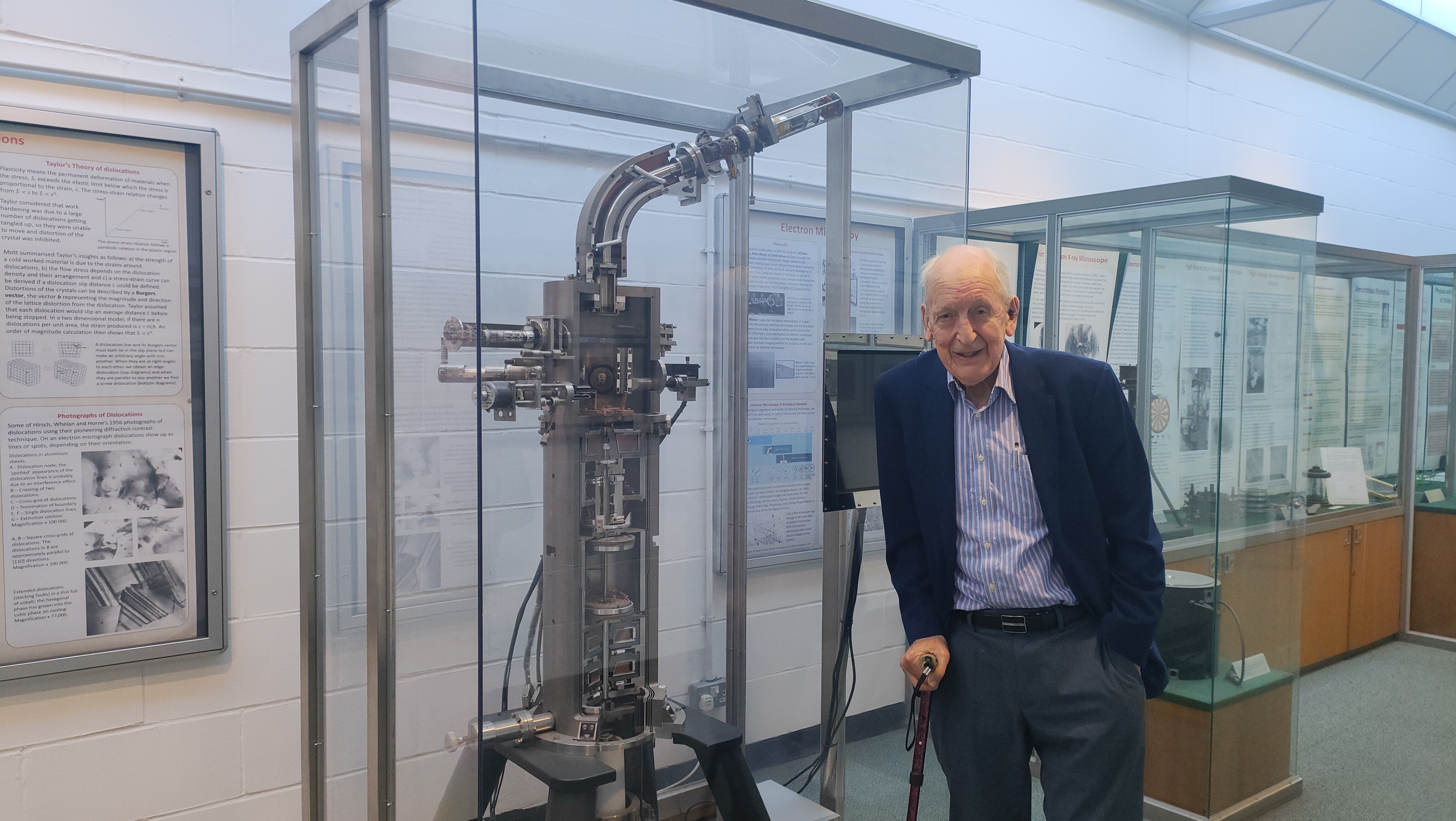
#AnniversaryStory
You’ve got work at 9am, and you’re making your way towards your department. You pass along Portugal Place and you look down through a grill into the basement of a house. There you see Francis Crick, resplendent in his dressing gown tucking into his breakfast and maybe thinking about the latest puzzle of the genetic code. You then walk on to Free School Lane and make your way into the old Cavendish Laboratory. For us, this may seem surreal. For Prof Archibald (Archie) Howie CBE FRS, this was just a Monday.
Professor Howie (born 8th of March 1934) is a pioneer in Transmission Electron microscopy and crystal defects; is a lifelong fellow of Churchill College (since its founding in 1960) and was Head of Department at the Cavendish Laboratory from 1989-1997. As one of our 150 stories for our 150th anniversary, we wanted to catch up with him to discuss his story, achievements and memories of his extraordinary long career at Cambridge.
After doing his undergraduate degree at the University of Edinburgh (1952-56), Archie was chosen to go to Caltech (USA) to study theoretical quantum physics under Richard Feynman and Murray Gell-Mann under a scholarship. “It was a valuable, fantastic experience, especially with Feynman, and I was very lucky. But I realised that though I was mathematically quite competent, I was not in that sort of class,” said Archie.
So Archie needed to find his niche. Upon reading the journal Nature, he found a paper from Mott, then Head of the Cavendish, on fermi surfaces- a relatively novel area of research that the Cavendish’s low temperature physics group were specialising in. “It gave me the idea that I should perhaps go into a field like metallurgy,” said Archie.
So he tentatively sent in a letter to Mott in 1957, requesting advice on whether he should pursue a PhD or go into industry. “Of course, this was very naïve in hindsight, because Mott didn’t give a moment’s thought to whether I wanted to go into industry and eventually sent me back a letter offering a PhD position!” said Archie. “He gave me a choice of either working in the low temperature group with Shoenberg and Pippard or working in Hirsch’s group specialising in electron microscopy and crystal defects.”
Archie needed to make a decision, and as is often the case, he went with his gut. “In my undergraduate degree I had come across the idea of dislocations, and I had found it quite interesting. So, I decided to go with Peter Hirsch’s group,” said Archie. “In hindsight, this was probably the luckiest thing in my career. It was like getting on board a high-speed train just as it left the platform.”
In 1956, Hirsch and his colleagues had made an exciting discovery. They had just managed to get Transmission Electron Microscope (TEM) images of the movement of dislocations within aluminium foil. Dislocations, imperfections in a crystal structure (like a missing piece in a jigsaw puzzle), are vital to the mechanisms that govern the mechanical and electrical properties of materials. Hirsch’s group had actually identified new forms of defects in these images. Since this point, the group continued to make more and more discoveries. So when Archie came in to the Cavendish, he found himself surrounded by innovation and discoveries. However, Archie had a secret weapon- his mathematical experience in Caltech. “I had an advantage over others due to my studies at Caltech. Electron microscopy imaging theory is kind of a small subsection of Quantum Mechanics which usually employs operators in Heisenberg’s formulation. However, in Electron microscopy, the detail of the electron waves is crucial, so actually Schrödinger’s equation is more useful. And I had the maths skills to work with it,” said Archie.
Having found his niche, it was not long before, with Mike Whelan, he made some significant contributions. He incorporated the wave nature of electrons to account for the image contrast, variations in intensity of the recorded Bragg reflection, from dislocations.
Image: Prof Archie Howie standing with the TEM used by the 1956 team to make the original image of dislocations
Pivotal to his work was having access to the EDSAC 2 computer, developed by the Mathematical Laboratory and made available to all scientists across the University. “In the days of EDSAC 2, if you wanted time on it, then you needed to go through Sir Peter Swinnerton-Dyer. And it turned out there were 3 categories of requests. There were requests, mainly from biologists, who gave tasks way too complicated for the capabilities of the machine. There were those that were so easy that Swinnerton-Dyer would do them there and then himself. And there were those, like ours, that could only be done by the machine,” remembered Archie.
“One thing I regret is we used to have acknowledgments at the end of the paper and we used to write something like ‘we thank Sir Nevill Mott for the facilities’ and whilst he helped, who we really should have been thanking were the EDSAC team,” said Archie.
Around that time, in 1960, Archie joined the newly founded Churchill College as a Research Fellow.
“We actually tried to get women into Churchill from its inception. It used to be a required statute to say ‘this is a men’s college’, and so we thought it would be great if we could just omit that, then we could accept women. Unfortunately, we were forced to put it in,” said Archie. “J.D. Cockcroft, master of Churchill at the time, passed away unexpectedly in 1967, which delayed such a major change even further. I mean they said all sorts of ridiculous things like ‘we’ll need special shower rooms and facilities for girls’ and there was a committee of around 20 of us, who had to answer all of these objections. Finally, along with King’s and Clare, we were the first undergraduate colleges to become mixed in 1972.”
In 1961, Archie developed the Howie-Whelan Equations along with M.J. Whelan. This was a major theoretical advancement that allowed for the interpretation of TEM images of dislocations. He later studied the effects of electron beam channelling between crystal planes, which allowed surprisingly thick crystals to be studied.
“It was an extraordinary time to be working in Hirsh’s group. He was an amazing supervisor,” recalled Archie. “He had fantastic stamina and energy. He would deliver undergraduate lectures at 9am and then come into work straight after, but he would be awake the whole night and sleep extraordinarily little. The main thing about him was he had this incredible enthusiasm that passed on to anyone. Whenever someone felt a bit down about their work, they would see him and everything would be fixed. One of the researchers once said to us ‘I’m thinking of leaving’, and we all said ‘go and see Hirsch first’. So there he went, looking exhausted, and like a flat car battery put on charge, he came out pulsating with energy and he didn’t leave, but that was everyone’s experience with Hirsch.”
In 1965, Archie wrote parts of a foundational textbook along with Hirsch, Robin Nicholson, Donald Pashley and Whelan, providing comprehensive descriptions of the techniques of electron microscopy. It ended up being known as the yellow bible amongst academics.
“As expected, the busy Hirsch was late to submit his sections of the book. At one point we even threatened to scratch his name from the authors’ list!” said Archie.
Also central to Archie’s work was the development of Scanning Transmission Electron Microscopes (STEM). This combined the high resolution of TEM with the SEM’s ability to handle multiple signals. The result is that local variations in crystal composition as well as structure can be imaged. Between 1975 and 2000, Archie, partnered by Mick Brown, oversaw a lot of the developments of STEMs. In 1979, with his students, he adapted a method known as annular dark-field imaging (ADF), pioneered by Albert Crewe, to allow for the information from the scattered electrons to be detected and used to construct an image. This technique became known as high-angle annular dark-field detection (HAADF) and it is now universally used in STEM.
Image: Prof Archie Howie with the STEM microscope he used extensively in his research
A lifelong fellow of Churchill, Archie continued to contribute to college life throughout his career, becoming a Director of Studies alongside Cavendish’s Radio Astronomer Anthony Hewish, who later won a Nobel Prize for the discovery of pulsars. “Hewish and I were both regularly marking College entrance exams and I can still point to the seats in the Dining Hall where we compared notes over lunch” said Archie. “He started to tell me about these weird signals and the “little green men” I felt ‘my god he’s gone bonkers’. I was quite cynical about this, thinking ‘oh no I’m now going to have to mark all of these entrance exams by myself!’”
Archie’s work in STEM culminated when his former student, Ondrej Krivanek, managed to correct the spherical aberration in the STEM in 1997. This brilliant Cavendish result came from a project organised by Mick Brown. The aberration distorts the image and decreases its resolution. By 2000, the aberration correctors were being sold commercially, and they soon became the industry standard.
“Krivanek was a really good student. He got very quickly adjusted to things in his first year and he was fantastically well organised,” said Archie. “He once researched where the best electron microscope was and it was in Japan. He asked for money from the Royal society to go there and I’m sure he had to navigate around the place all on his own. And he managed to get some brilliant images from the microscope which made everyone sit up.”
Archie finished his tenure as Cavendish Head of Department in 1997, navigating challenging changes in research funding and research group structure as well as the switch to a four-year undergraduate degree. In 1998, he received a CBE for his services to electron microscopy and continued his research in Cambridge until he retired in 2001. Since then his research interest has focussed on “aloof beam spectroscopy” studying the energy losses of a STEM beam passing close to but not through a crystal. This has involved extensive collaboration with Pedro Echenique, a former visiting fellow of Churchill, working at the Donostia International Physics Centre (DIPC). Archie still lives in Cambridge and can often be seen riding a bike along Portugal Place, Free School Lane and the West Cambridge campus!
Main Image: Professor Archibald Howie CBE FRS, 1995
Text credit: Dhruv Shenai


